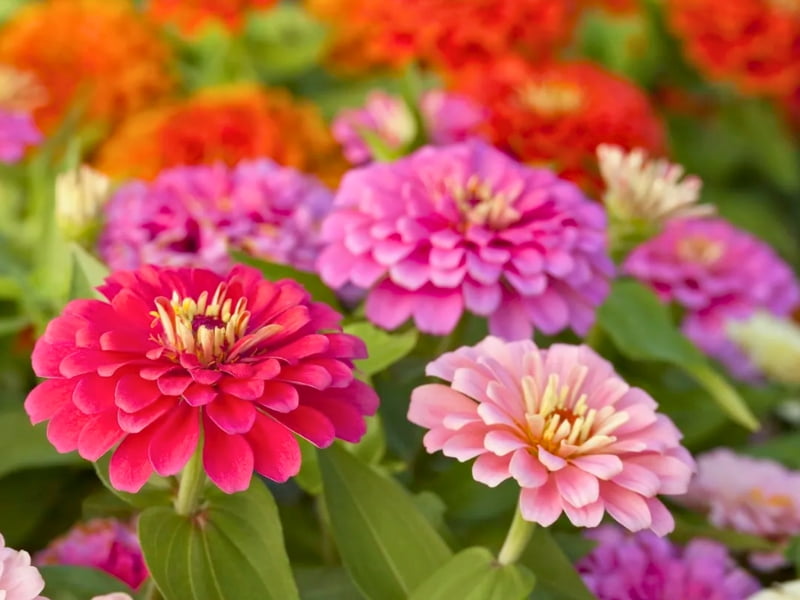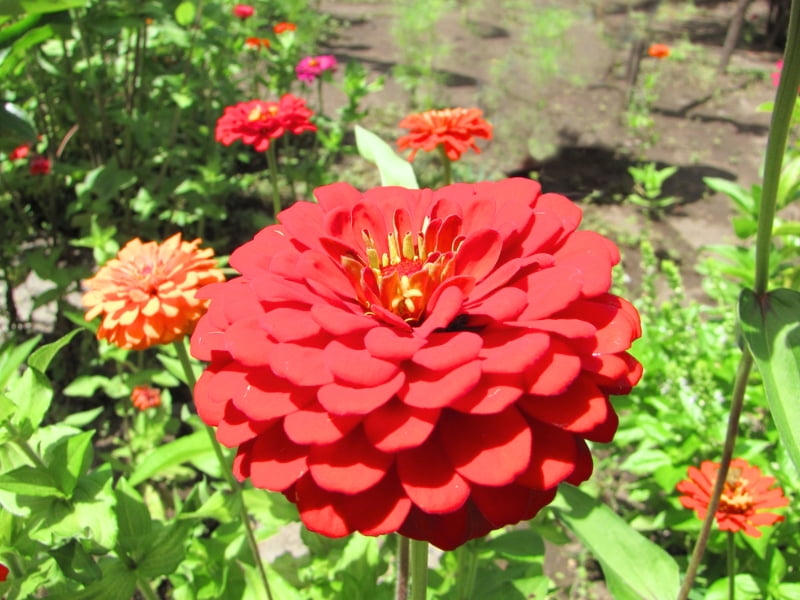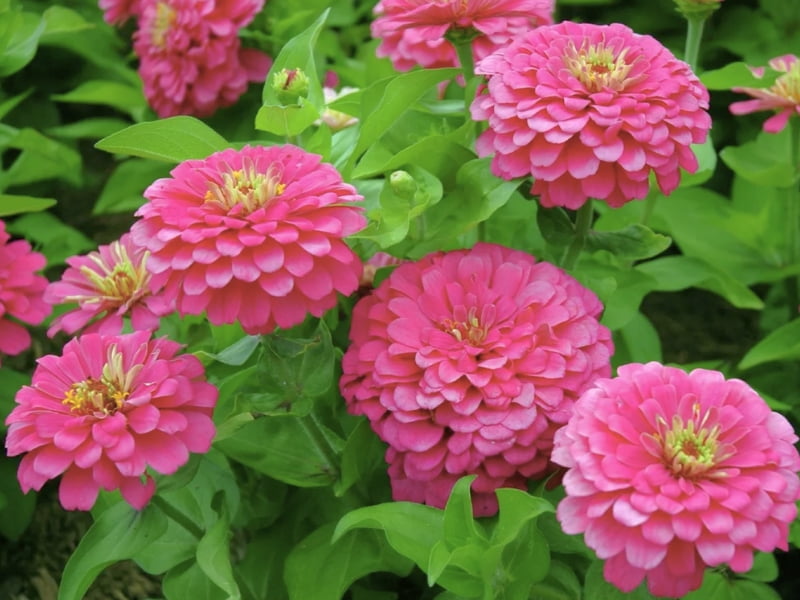Common Zinnias, also known as Zinnia elegans, are vibrant annual flowers beloved for their wide array of colors and ease of growth. These garden favorites, along with their related species and cultivars, bring a splash of brilliance to any landscape, attracting butterflies and beneficial pollinators.
At Gardencenterpoint.com, we understand the joy these blooms bring. This comprehensive guide will delve into everything you need to know about how to grow zinnias, from seed starting to zinnia care tips, ensuring a stunning display throughout the growing season.

What is Common Zinnia?
Common Zinnias ( Zinnia elegans) are annual plants, meaning they complete their life cycle in one growing season. Originating in Mexico, they thrive in warm weather and full sun. Zinnias are known for their daisy-like or dahlia-like flower heads, which come in a vast spectrum of colors, including red, pink, orange, yellow, purple, white, and even green. Heights can range from a compact 6 inches to a towering 4 feet, depending on the variety.
The popularity of zinnias stems from several factors:
- Ease of Growth: Zinnias are notoriously easy to grow from seed, making them perfect for beginners.
- Long Bloom Time: They provide continuous color from early summer until the first frost.
- Attract Pollinators: Butterflies and hummingbirds are drawn to their vibrant blooms.
- Cut Flower Beauty: Zinnias make excellent cut flowers, lasting for a week or more in a vase.
- Variety: There’s a zinnia for every garden style and preference, thanks to the numerous cultivars available.
A study by the University of Kentucky Extension service highlights the importance of zinnias as a pollinator-attracting plant. Their research found that zinnias are among the top choices for attracting a variety of butterfly species, contributing to biodiversity in gardens and landscapes. (Source: University of Kentucky Extension, “Attracting Butterflies to Your Garden”).
How to Grow Zinnias
Growing zinnias is a rewarding experience, and following these steps will maximize your success:
Choosing the Right Zinnia Variety
Before you start, select a zinnia variety that suits your garden’s conditions and your aesthetic preferences. Consider:
- Height: Dwarf varieties (e.g., ‘Thumbelina’) are great for borders and containers, while taller varieties (e.g., ‘Benary’s Giant’) are perfect for the back of the border or as cut flowers.
- Flower Form: Choose from single, semi-double, or double blooms.
- Color: Explore the rainbow of zinnia colors to create the perfect palette for your garden.
- Disease Resistance Some varieties, have a higher disease resistance, than others.
Starting Zinnia Seeds Indoors (4-6 weeks before last frost)
- Timing: Start seeds indoors 4-6 weeks before the last expected frost in your area. You can find your region’s average last frost date through your local extension office or online resources.
- Materials: You’ll need seed-starting trays, a soilless seed-starting mix, and a light source (grow lights are ideal).
- Sowing: Sow seeds 1/4 inch deep in the seed-starting mix. Keep the mix moist but not waterlogged.
- Germination: Zinnia seeds typically germinate within 7-10 days at a temperature of 70-80°F (21-27°C).
- Light: Provide seedlings with 12-14 hours of light per day.
- Hardening Off: Gradually acclimate seedlings to outdoor conditions for a week before transplanting. This involves placing them in a sheltered location for increasing amounts of time each day.
Direct Sowing Zinnia Seeds Outdoors (after last frost)
- Timing: Sow seeds directly into the garden after all danger of frost has passed and the soil has warmed to at least 70°F (21°C).
- Soil Preparation: Choose a location with full sun (at least 6 hours per day) and well-drained soil. Amend the soil with compost to improve drainage and fertility.
- Sowing: Sow seeds 1/4 inch deep and 2-3 inches apart. Thin seedlings to the recommended spacing (usually 6-18 inches apart, depending on the variety) once they have a few sets of true leaves.
2.4. Transplanting Zinnia Seedlings
- Timing: Transplant seedlings outdoors after the last frost, when they have several sets of true leaves.
- Spacing: Space seedlings according to the variety’s mature size.
- Watering: Water thoroughly after transplanting.
Zinnia Care Tips
Watering
- Frequency: Water zinnias deeply and regularly, especially during dry periods. Aim to keep the soil consistently moist but not soggy.
- Method: Water at the base of the plants to avoid wetting the foliage, which can lead to fungal diseases. A soaker hose or drip irrigation system is ideal.
- Mulching: Apply a layer of organic mulch (such as shredded bark or compost) around the plants to help retain moisture and suppress weeds.
Fertilizing
- Type: Use a balanced, water-soluble fertilizer (e.g., 10-10-10) every 4-6 weeks. Alternatively, you can incorporate a slow-release granular fertilizer into the soil at planting time.
- Avoid Over-Fertilizing: Excessive nitrogen can lead to lush foliage but fewer flowers.
Sunlight
- Requirement: Zinnias need at least 6 hours of direct sunlight per day to thrive. More sun equals more blooms.
- Shade Tolerance: While zinnias prefer full sun, some varieties can tolerate partial shade, but flowering may be reduced.
Soil and Drainage
- Ideal Soil: Zinnias prefer well-drained, fertile soil with a slightly acidic to neutral pH (6.0-7.0).
- Improving Drainage: If your soil is heavy clay, amend it with compost or other organic matter to improve drainage.
Deadheading and Pinching
- Deadheading: Remove spent flowers regularly to encourage continuous blooming. Simply snip off the faded flower head just below the flower and above the next set of leaves.
- Pinching: Pinch back young plants when they are about 6-8 inches tall to promote bushier growth and more flowers. Pinch out the central stem just above a set of leaves.
Staking (for taller varieties)
- Support: Taller zinnia varieties may require staking to prevent them from flopping over, especially in windy locations.
- Methods: Use stakes and twine or plant supports to provide support.

Common Zinnia Pests and Diseases
While zinnias are relatively easy to care for, they can be susceptible to certain pests and diseases.
Common Pests
- Aphids: Small, soft-bodied insects that suck sap from plants. Control with insecticidal soap or neem oil.
- Spider Mites: Tiny pests that create webbing on leaves and cause yellowing. Control with insecticidal soap or miticide.
- Japanese Beetles: Metallic green beetles that skeletonize leaves. Handpick or use traps.
Common Diseases
- Powdery Mildew: A fungal disease that appears as a white, powdery coating on leaves. Improve air circulation, avoid overhead watering, and use a fungicide if necessary.
- Bacterial Leaf Spot: Causes brown spots on leaves. Remove infected leaves and avoid overhead watering.
- Alternaria Leaf Spot: Another fungal disease that causes brown spots with concentric rings. Improve air circulation and use a fungicide.
Prevention
- Good Air Circulation: Provide adequate spacing between plants to promote good air circulation, which helps prevent fungal diseases.
- Watering Practices: Water at the base of the plants to avoid wetting the foliage.
- Disease-Resistant Varieties: Choose zinnia varieties that are known for their resistance to common diseases.
- Crop Rotation: Avoid planting zinnias in the same location year after year to prevent the buildup of soilborne diseases.
Zinnia Flower Meaning and Symbolism
Zinnias have a rich history of symbolism, with different colors conveying different meanings:
- Red Zinnias: Symbolize steadfastness, lasting affection, and family bonds.
- Pink Zinnias: Represent joy, happiness, and romantic love.
- Orange Zinnias: Convey enthusiasm, excitement, and energy.
- Yellow Zinnias: Symbolize daily remembrance, friendship, and cheerfulness.
- Purple Zinnias: Represent royalty, admiration, and accomplishment.
- White Zinnias: Symbolize purity, innocence, and goodness.
- Mixed Zinnias: Often given as a symbol of thinking of an absent friend.
Harvesting Zinnias for Cut Flowers
Zinnias make beautiful and long-lasting cut flowers.
- Timing: Harvest zinnias in the morning after the dew has dried.
- Selection: Choose flowers that are fully open or just beginning to open.
- Cutting: Use sharp, clean shears or a knife to cut the stems at an angle.
- Stem Length: Cut stems as long as possible.
- Conditioning: Remove any leaves that will be below the waterline in the vase.
- Vase Life: Zinnias can last for 7-10 days in a vase with fresh water and flower food. Change the water every 1-2 days.
Saving Zinnia Seeds
Saving zinnia seeds is a great way to propagate your favorite varieties and save money.
- Timing: Allow the flower heads to dry completely on the plant. The petals will turn brown and crispy.
- Harvesting: Once the flower heads are dry, simply rub them between your fingers to release the seeds.
- Cleaning: Separate the seeds from the chaff (the dried flower parts).
- Storing: Store the seeds in a cool, dry place in an airtight container. Properly stored zinnia seeds can remain viable for 3-5 years.

Common Zinnia Varieties
The world of Common Zinnias (Zinnia elegans) offers an astonishing variety of choices, ensuring there’s a perfect fit for every garden style, color preference, and growing condition. From petite dwarfs ideal for edging to towering giants perfect for backdrops and cut flower arrangements, the diversity within this species is a key part of its enduring appeal. Understanding the different types available allows gardeners to select zinnias that will thrive and contribute precisely the desired aesthetic. This section will explore several categories of common zinnia varieties, highlighting their distinct characteristics and recommending specific cultivars.
Classification by Height:
One of the most practical ways to categorize zinnias is by their mature height. This directly impacts their placement in the garden and their suitability for various purposes.
- Dwarf Zinnias (Under 12 inches): These compact varieties are excellent for container gardening, border fronts, and edging pathways. They tend to produce a profusion of smaller blooms, creating a dense carpet of color. Examples include the ‘Thumbelina’ series, which offers a mix of vibrant colors and grows to about 6-8 inches tall. Another excellent choice is the ‘Magellan’ series, known for its large, dahlia-like flowers on short, sturdy plants. These typically reach 10-12 inches.
- Medium Zinnias (12-24 inches): This is a versatile group that works well in mixed borders, mid-border plantings, and larger containers. They offer a good balance between plant size and flower size. The ‘Dreamland’ series is a popular choice, producing large, double blooms in a range of colors. The ‘Zahara’ series, exceptionally disease-resistant, also falls into this category, offering single and double blooms and excellent tolerance to heat and humidity. The State Fair series offer large blooms.
- Tall Zinnias (Over 24 inches): These majestic varieties are best suited for the back of borders, creating a dramatic backdrop for shorter plants. They are also the preferred choice for cut flower gardens, providing long, strong stems. ‘Benary’s Giant’ is the classic tall zinnia, reaching 3-4 feet tall and producing enormous, dahlia-like flowers in a wide array of colors. ‘California Giant’ is another excellent choice, with similar height and large, colorful blooms.
Classification by Flower Form:
Zinnia flower forms range from simple single blooms to elaborate doubles, adding another layer of visual interest.
- Single-Flowered Zinnias: These have a single row of petals surrounding a prominent central disk. They tend to have a more natural, wildflower-like appearance. The ‘Profusion’ series, known for its disease resistance and continuous blooming, includes many single-flowered varieties.
- Semi-Double-Flowered Zinnias: These have several rows of petals, creating a fuller appearance than single-flowered varieties, but the central disk is still visible. The ‘Zowie Yellow Flame’ is a striking example, with its red and yellow bicolor petals.
- Double-Flowered Zinnias: These have numerous rows of petals, completely obscuring the central disk and creating a full, rounded flower head. The ‘Benary’s Giant’ and ‘Dreamland’ series are predominantly double-flowered. The cactus-flowered zinnias, a sub-type of double, have quilled or rolled petals, adding a unique textural element.
Notable Zinnia Series and Cultivars:
Beyond height and flower form, certain zinnia series have become renowned for specific traits:
- Zahara Series: This have high desease resistence, especially to powdery mildew and leaf spot. They do well in hot and dry conditions.
- Profusion Series: This series is known for its exceptional disease resistance, particularly to powdery mildew, and its long bloom period. It includes both single and semi-double flowered varieties.
- Benary’s Giant Series: The gold standard for tall, cut-flower zinnias, offering large, double blooms in a vast range of colors.
- Thumbelina Series: A classic dwarf series, perfect for compact spaces and containers.
- Magellan Series: Known for large, dahlia-like flowers on compact plants, making them suitable for both containers and borders.
- Queen Lime Series: The offer unique colors, like lime green, and add special interest to any garden.
| Variety | Height (inches) | Flower Form | Color(s) | Characteristics |
| Benary’s Giant | 36-48 | Double | Mix of bright colors | Excellent cut flower, tall and stately |
| Thumbelina | 6-8 | Semi-double | Mix of bright colors | Dwarf variety, perfect for borders and containers |
| State Fair Mix | 24-36 | Double | Mix of bright colors | Large, showy blooms |
| Zowie Yellow Flame | 24-30 | Semi-double | Red and yellow | Unique bicolor |
| Queen Lime Series | 24-30 | Semi-double, Double | Lime green, blush, orange, red | Unusual and striking colors |
| Zahara Series | 12-18 | Single, Double | Various | Very desease resistant. Sun and heat-loving |
Where to Buy Zinnia Seeds and Plants
Gardencenterpoint.com does not directly sell zinnia seeds or plants. Instead, we connect you with reputable nurseries and online retailers who offer a wide selection of high-quality zinnias. Check out some trusted sources:
- Burpee: A well-known seed company offering a wide range of zinnia varieties. (Navigational: “Burpee zinnias”)
- Johnny’s Selected Seeds: A reliable source for organic and heirloom zinnia seeds.
- Park Seed: Another popular seed company with a diverse selection of zinnias.
- Local Nurseries: Visit your local garden centers for zinnia seedlings and plants. They can also offer advice tailored to your specific growing region.

Leave a Reply